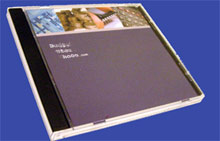A little background about myself:
Life before Microstock
It's the dawn of the new millennium. My first 'megapixel' digital camera also had mega-noise, and ate 4 AA rechargeables taking less than 30 shots, that was fine as I could only fit 11 of the 1.3 megapixel images on my 4MB CF card. It was a time when anyone who had a need for images had a row of photodisk and eye-wire resource books on their shelves with lots of colourful and for the time very dynamic looking shots with effects like slap zoom and blurring done mostly in camera. The rest of 'us' made do with clipart disks.
What landed me in stock photography (I use that term VERY loosely to describe what I did) was the feeling that stock was way over-priced, or at least it was way over priced for web resolution images - there was no middle ground between clipart and what is now called traditional RF. There was nowhere to go to get a reasonable looking image on the cheap, not necessary something of such high quality as the stock agencies supplied but something that was better than those awful clipart collections... there was a gap in the market, myself and plenty of other people could see that. I set about creating a collection of home grown CD-ROMS of stock images. The 3 CDs I eventually created in my spare time sold several hundred copies between 2000 and 2004. About 1000 images on each disk sold for 29 GBP plus shipping. This was the bottom end of the market.

All of this set me up to never have a problem with microstock and it's pricing like many photographers did. Perhaps because I could see what digital cameras were going to do - if I could make money doing this then there was nothing stopping anyone else doing the same - it was just a matter of time. Back in 2000 I was convinced that only a film camera would be able to take viable 'professional stock' images for at least 10 years, I shot film and digital, the digital was the start of that would become my microstock. I was a little out with my 10 year estimation, it was half that time, I'd say it was 2005 before the professionals started to switch in earnest, before that digital was the realm of the press photographer, and microstock.
Downloads and Micropayments
A lot of the digital images I created I gave away. They were the 'snaps' and the quality of that first camera was not good. (infact utterly awful by today's standards, web cams and phones take better images). The Images I gave away for free were mostly textures, and abstract light effects, I could see that while they did have some commercial value it was a real struggle, no impossible, for the small player to set-up in business selling those images. There was no easy to take 'micropayments' for the small time internet business.

By around 2001 (perhaps earlier) I was 'dabbling' at a website called zden, the images had grown to 1600x1200 pixels and were much better quality. Zden was a business model that turned out not to work. Little record remains of zden.com but a few scattered referral links and an ibm white paper. At Zden you earned 'zees' each time an image was bought or downloaded (in my case I selected 'free' so instead of charging 1000 zees (1 dollar) I earned 1 zee per download so 1000 downloads got me a dollar. It was an amazing website for the time, and to be honest the early istock was nowhere close. For me this was the start of my microstock journey - I was primed for high volume low cost image sales.
istock came next for me, I'd been to the website several times before I applied to contribute (in 2003 so istock tell me). After zden failed without a payout I was a little sceptical, I thought istock might go the same route. Comparing the two sites even by the standards of the day, "istockphoto" was a really cheap sounding domain name, and the istock site looked awful. I didn't invest too much time in the "new" site. A few months later I had a quick look what those 20 or so "uploads on a Saturday afternoon" had earned me, it was enough to really get me thinking that a few hundred such images would be a very nice income.
Late 2005 I felt it was time to diversify into more 'new' websites. I joined about 4000 other contributors at Fotolia. Shutterstock came a little later in 2006, I wasn't too sure about this 'subscription' thing ;)
The rest as they say is history. One day in early 2008 when I went to check up on some stats at a few agencies I had been using. To my horror a couple of them had been a complete waste of time for the past year. I went looking for a site that had reviews or at least a list of these agencies. It was not a problem for the big 6 or 7 people had published results for them but what about the rest? I could see on the forums there were lots of sites, which, if any of them were any good, more importantly which were known to be useless. Do some digging and it was there but the information did not flow freely. There was no way to compare all the agencies. Microstock Insider was born.
So the Microstock boat has already sailed?
Not by any means. Although I started in 2003, It was at a very casual rate, not until 06/07 did I start uploading more images and even then it was at a rate of at most 100 per year, In this respect what I do and the amount of images I contribute still puts me in the ranks of other part time microstock contributors. At the rate I'm going direct microstock sales might never be more than 10% of my income (another 75% is in some way microstock and photography related). Considering the time I spend shooting and uploading that 10% is not such a bad thing!
But, but look at all those images?!
Look to top ranking photographers for inspiration, don't try to emulate them and certainly don't compare the number of images you have with their, often massive, image portfolios. Those 'people' at the top of the lists are often production companies, doing a comparison invariably ends in the fatalistic statement "how can I compete with that?!", for most microstock photographers they are not the competition, they operate in a different league. As a beginner or small time photographer your competitors are your peers, people like you working the same hours and submitting at the same rate: take better photos than them and pick the right subjects and you will be a success.
So that was my story, what's yours?



It's quiet in here! Add new comment